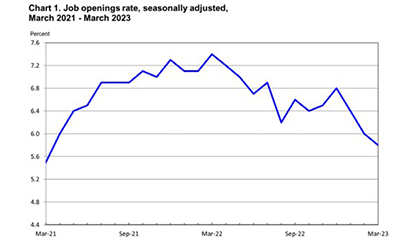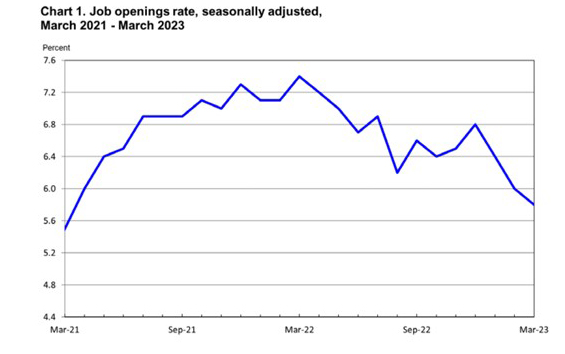
Job Openings Fall to 2-Year Low

In the first of four major jobs reports this week, the Bureau of Labor Statistics reported job openings fell to their lowest level since April 2021.
The monthly Job Openings & Labor Turnover Survey, known as JOLTS, said job openings fell by 384,000 to 9.6 million on the last business day of March. Over the month, the number of hires and total separations fell to 6.1 million and 5.9 million, respectively. Within separations, quits fell to 3.9 million, while layoffs and discharges rose to 1.8 million.
Job openings were 1.6 million lower than in December. The job openings rate stood at 5.8 percent in March and was down by 1.0 percentage point since December. Hires fell to 6.1 million; the rate held at 4.0 percent.

Separations stood at 5.9 million in March; the rate was 3.8 percent for the fourth month in a row. Quits changed little at 3.9 million and 2.5 percent, respectively. The number and rate of layoffs and discharges increased to 1.8 million (+248,000) and 1.2 percent, respectively.
“Although still high, this was the lowest level of job openings since April 2021,” said Sarah House, Senior Economist with Wells Fargo Economics, Charlotte, N.C. “The quit rate edged lower and the layoffs and discharges rate ticked higher, trends that are consistent with a labor market that continues to incrementally cool. In an absolute sense, the labor market remains tight with openings and quits still above pre-pandemic levels and involuntary separations just getting back to what prevailed in 2018-2019. But a clear trend is emerging, and we expect labor demand to keep receding in the months to come.”
House said the JOLTS report offered additional evidence that supply and demand in the labor market are coming into better balance. “On balance, the recent JOLTS data reinforce the idea that labor demand is cooling alongside labor supply that has steadily expanded in recent months,” she said. “On the supply side, the labor force participation rate has increased four months in a row, and the prime-age employment-to-population ratio is at its highest level in nearly 22 years. On the demand side, job openings appear to have a clear downward trajectory, and a falling quit rate is indicative that lucrative new opportunities for workers are not quite as plentiful as they were a year ago. The softening trends in openings, quits and layoffs add to the evidence provided by small business hiring plans, PMIs and a variety of wage measures that the jobs market is slowly losing steam.”
The parade of jobs reports continues today when ADP, Roseland, N.J., releases its monthly National Employment Report. On Thursday, the Labor Department releases its weekly Initial Claims report. And on Friday, BLS releases its monthly Employment Report, showing job creation for April. MBA Chief Economist Mike Fratantoni will provide commentary and analysis in the Monday, May 8 edition of MBA NewsLink.
